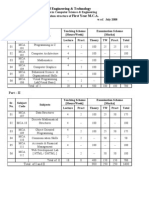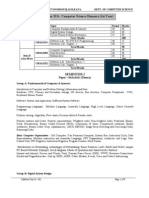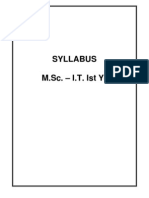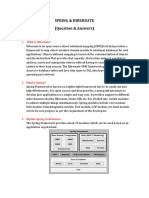0 ratings0% found this document useful (0 votes)
41 viewsComputer Science
Uploaded by
vishvadeepchopadeCopyright
© © All Rights Reserved
Available Formats
Download as PDF, TXT or read online on Scribd
0 ratings0% found this document useful (0 votes)
41 viewsComputer Science
Uploaded by
vishvadeepchopadeCopyright
© © All Rights Reserved
Available Formats
Download as PDF, TXT or read online on Scribd
You are on page 1/ 10
Syllabus of B.Sc.
(Computer Science)
B.Sc. I Year effective from 2004-2005
Theory:
I Paper : Introduction to Computer & Programming
II Paper : Fundamental of Digital Electronics and Computer
Organization
III Paper : Operating System Concepts Practical: Practical will be based
on C programming, digital Electronics & O.S. commands
B.Sc. II Year effective from 2005-2006
Theory:
I Paper : Introduction to Data Structure & Algorithm
II Paper : Discrete Mathematics
III Paper : Numerical and Statistical Analysis Practical: Practical will be
based on Data Structure, Algorithms, and Numerical
B.Sc. III Year effective from 2006-2007
Theory:
I Paper : Computer Architecture & Microprocessors
II Paper : Introduction to Database Management System
III Paper : Object Oriented System
IV Paper : Data Communication & Computers Networks
Practical : Practical will be based on DBMS Programming, OOP (using
C++)
DETAILED SYLLABUS OF B.Sc. I YEAR
I Paper: (Introduction to Computer & Programming)
Introduction:
Overview of Digital Computer, Major Components of digital computer,
Hardware, Software, Software & Firmware, Computer Application in
various fields of science and managements;
Data Representation:
Decimal and binary number system, Decimal-binary conversion, Octal
number system, Hexadecimal, BCD number, Binary arithmetic,
Alphanumeric representation, Complements, r and (r-1)'s complements,
Fixed point and floating point representation;
Introduction to Programming:
Concept of algorithm, flowchart, data flow diagram, editing tools (turbo C
editor);
Programming in ‘C’:
An overview of C, Structure of C program, Storage class specifier & data
types, variable declaration, operators & expressions;
Control Statements:
True & false in C, C statements, Conditional statements, if, switch, for,
while, do-while, break, exit (), continue & go to;
Basic I/O:
Formatted & unformatted I/O, Concept of sub programming & functions,
examples of different types of functions, Parameter passing technique,
Recursion;
Arrays:
One dimensional, two dimensional & Multi dimensional arrays;
Pointers:
Concept of pointers, pointer operators, pointer expressions, pointer and
array, Strings and string library functions;
Structure & Unions:
Overview of structure & unions, Structure and function, array of structure,
structure pointer, Nested structure;
File Management:
Defining and opening a file, closing a file, input/output operations.
II Paper: (Fundamental of Digital Electronics and Computer
Organization)
Digital Circuits:
Logic gates, Boolean algebra, Karnaugh Maps;
Combinational Circuits:
Half adder, Full adder, Flip-flops� RS flip-flop, D- flip-flop, JK, T-flip
flop, Edge-triggered flip flop, Encoders, Decoders, multiplexers, Registers�
shift register, buffer register counters;
Basic Computer Organization:
Instruction code, direct & indirect addresses, Timing and control signals,
Instruction cycle, memory reference Instruction, I/O Instructions;
Computer Arithmetic:
Addition and subtraction with signed magnitude data, multiplication
algorithms & Booth algorithm, hardware algorithm;
Memory:
Memory hierarchy, memory write ability and storage performance, memory
units, memory types- ROM, masked programmed ROM, OTP ROM,
EPROM, EEPROM, flash memory, Introduction to read-write memory �
RAM, SRAM, DRAM, PSRAM, MVRAM. Cache memory, Cache mapping
technique, virtual memory concept, EDO RAM, Synchronous and enhanced
synchronous DRAM, Rambus DRAM (RDRAM). Transistor as a switch,
Switching time, Logic circuit, active and passive logic circuits, diode logic,
register logic, register transistor logic (RTL), Register capacitor transistor
logic (RCTL), Integrated injection logic (I2 L), transistor- transistor logic
(TTL), Emitter coupled logic (LCTL) CML and CMOS logic interfacing
TTL, and CMOS logic, their characteristics and uses;
Multi vibrators:
Astable, monostable, bistable, Schmidt;
A/D Converters:
Time window and slope converters, Tracking A/D and successive
approximation converters, Digital to analog converters, LED and LCD
display, seven segment display.
III Paper: Operating System Concepts
Operating System Overview:
Computer system structure, operating system structure, OS functions,
facilities;
Memory Management:
Single contiguous allocation, Partioned allocation, Relocatable partioned
allocation, paging, segmentation, demand paged allocation;
Processor Management:
State models, Job schedulers, Process scheduling, Job and process
synchronization, Race condition, deadlocks, Deadlock detection, recovery &
prevention. Device Management: Different techniques, Input-output devices,
storage devices, Information Management: Files systems, Features of file
system, General model of file, Logical & physical file system;
Case study of DOS and windows O.S. (Introductory Concepts).
]
DETAILED SYLLABUS OF B.Sc. II YEAR
Paper I: (Introduction to Data Structure & Algorithm)
Introduction Data Structure:
Concept of Data Types- Primitive data type, Abstract data type,
Polymorphic data type. Description of various data structure, Algorithms,
Performance analysis & Measurement. Defining problems, Designing
program, Coding, Testing, Debugging, Documentation of Program, Concept
of recursion, examples of some recursive functions.
Arrays:
Definition, One dimensional, multi dimensional arrays, representations in
memory;
Stacks & Queues:
Concept of stack and queue, Implementation of stack and queues in memory
using array & Pointer Application of stack and queues. Evaluation of
expansion (Postfix, Infix, Prefix), Circular queues - Priority queues;
Linked List:
Introduction of Linked list, Representation of Linear linked List, Operation
of Linear linked list.
Trees:
Introduction and basic terminologies, Binary tree, Binary search tree,
Representation of Binary search tree using array & linked list. Searching &
Sorting Technique and their analysis of algorithm.
Searching:
Linear search, Binary search
Sorting:
Bubble sort, Quick sort, Insertion sort, Merge sort.
II Paper: (Discrete Mathematics)
Fundamentals:
Sets, Subsets, Operation on Set, Finite & Infinite Sets, Relations &
Properties of Relations, Equivalence Relations Boolean Algebra Poset.
Lattices:
Lattice as Poset, Properties of Lattice, Sublattice, distributed &
Complemented Lattice;
Boolean algebra:
Boolean Lattice & Boolean Algebra, Uniqueness of Finite Boolean Algebra
Boolean function & expression, Use of K-maps. Graph Terminology &
Application of graphs, Finite & Infinite Graphs, Homomorphism,
Subgroups, Walks Paths & Circuits, Connected graph, Eulaline & Euler
graphs, Operations on graphs, Hamiltonian Path and Circuits;
Trees:
Properties of Tree, Distance & Center in Tree, Rooted and Binary Trees,
Spanning Trees, Matching, Matrix Representation, Graph, Coloring,
Chromatic Partitions and Coverings, Directed Graph;
Mathematical Logic:
Statements & Notations, Tautologies, Disjunctives & Conjunctives Normal
forms, Equivalence of Statements.
III Paper: (Numerical and Statistical Analysis)
Approximations & Errors:
Significant figures, Accuracy & precision, Different types of errors, Error
propagation, Total Numerical error with control;
Roots of equations:
Graphical Method, Bisection methods, False Partition method,
Newton Raphson method, Secant method, Convergence;
System of Linear Algebraic equation:
Matrix notation, Representation of simultaneous linear algebraic equation
in matrix form, Determinants, Crammers Rule, Gauss-Jaurdan and LU
decomposition methods, Pivoting and scaling, Interactive Gauss-Seidel
method , Introduction and Curve fitting, Lagrangian polynomials, Newton's
methods, Forward Difference methods, Numerical differentiation by
polynomial fitting;
Numerical Integration:
The rectangle rule, Trapezoidal rule, Simpron 1/3 and 3/8 rule;
Statistical Analysis:
Measure of Central Tendency, Preparing frequency distribution table, Mean,
Arithmetic mean, Harmonic mean and Measure of Dispersion, Skewness &
Kurtosis, Ranges, Mean deviation Standard deviation, Coefficient of
Variation, Moments Skew ness, Kurtisis, Correlation;
Linear regression:
Polynomial regression, multiple linear regression.
DETAILED SYLLABUS OF B.Sc. III YEAR
I Paper: Computer Architecture & Microprocessors
Principles of Computer Design, basic components of digital computer
system, overview of construction and operation of arithmetic logic unit
(ALU);
Register transfer and micro operators:
Register transfer language, bus and memory transfers, arithmetic micro
operators, logic micro operators, Shift micro operators, Bus structure,
multiple bus hierarchies, elements of bus design, PCI bus structure;
Memory:
Linear selected memory organization and coders. Dimension of memory
access, connecting memory chips to a computer bus, Magnetic disk
memories, Floppy disk, Magnetic tape, Cassettes and cartridges;
Input-Output Devices:
Fundamental of keyboards, printers, CRT and LCD displays devices and
terminals;
Central Processing Unit (CPU):
General register and organization, Memory stack, One address and two
address instructions, data transfer, arithmetic logic and shift instructions,
software and hardware interrupt (Only brief introduction), arithmetic and
instruction pipe lines;
Control Unit:
Construction of instruction word, instruction cycle and execution cycle
organization of control registers, Sequence of operation of control registers,
controlling arithmetic operators, BRANCH, SKIP or JUMP instructions,
SHIFT instructions, Register language, Microprogramming.
II Paper: Introduction to Database Management System
Concept of Database and its evaluation, Data abstraction and data
integration, the three level architecture of a DBMS, Components of a
DBMS, data models and their implementations: Relational, Network,
Hierarchical. Relational data manipulation: Relational algebra, relational
calculus, SQL;
Relational Database Design:
Functional dependencies, 1st to 3rd Normal form, BCNF, FoxPro�
Introduction to FoxPro, database construction, searching, sorting, indexing,
updation, Reports, Screen designing, Programming concepts, Managing
numbers & data.
III Paper: Object Oriented System
1. Introduction to Object Oriented Concept: Overview of object
oriented system, Abstract data Types, Inheritance, Polymorphism,
Object Identity, Object Modeling Concepts, Object Oriented Design,
Object Oriented Programming Languages, Object Oriented Database.
2. C++ Programming Language: Overview of C++, Programming
Paradigm, Support For Data Abstraction, Support for Object Oriented
Programming, Declaration and Constants, Expression and Statement,
Function and Files: Linkages, How to Make a Library, Functions.
3. Classes and Objects: Definition of Class, Class Declaration, Class
Function Definition, Member Function definition inside and outside
the class declaration, Scope resolution operator(: :), Private and Public
member function, Nesting member function, Creating Objects,
Accessing Class data members, Accessing member functions, Arrays
of Objects, Objects as function arguments.
4. Operator Overloading: Operator Function, User Defined Type
Conversion, Litreral, large objects, Assignments and Initialization,
subscripting, function call, dereferencing, increment and decrement, A
string Class, Friends and members.
5. Inheritance through Extending Classes: Concept of Inheritance,
Base Class, Derived Class, Definig derived classes, Visibility modes,
single inheritance.
6. Streams, Templates and Design of Libraries: Output, Input,
Formatting, Files and Streams, C-I/O, Design of Libraries.
7. Object Oriented Analysis & Design: Object Oriented Analysis,
System Design, Object Design, Semantic & Entity, Relationship &
Modeling, Overview of Existing Methodology. Booch's OOA and
OOD Approach.
IV Paper: Data Communication & Computers Networks
Data Communication System:
Purpose, Components: Source, transmitter, transmission System, receiver
and destination, Data transmission: Frequency, Spectrum and Bandwidth,
Analog and digital data transmission, Data and signal, Analog and digital
signaling of analog and digital data, Modem, Modulation techniques,
CODEC, Digital transmitter etc. Transmission impairments: Attenuation and
attenuation distortion, delay distortion, noise, Introduction to network, OSI
reference model, TCP/IP reference model, Transmission Media: Magnetic
media, Twisted-Pair cables, Baseband & Broadband Coaxial cables, Fiber
optics.
Wireless Transmission:
Radio Transmission, Microwave Transmission, ISDN, ATM, Data Link
Layer: Services, Framing, Error Control, Error-detecting & Correcting
Codes, Data Link Protocols: Stop-and-wait Protocol, Sliding Window
Protocol.
HDLC:
Static & Dynamic Channel allocation in LANs & MANs
Multiple Access Protocols:
ALOHA, CSMA/CD, IEEE-standards 802.3 and Ethernet, 802.4, Token
Bus, 802.5 Token ring, Bridges, Routers, Gateways, Routing algos,
Congestion control algos, Internetworking. The TCP/IP Protocol, IP
Addressing, Subnets.
You might also like
- Basic Teamcenter: Bill of Material ConceptNo ratings yetBasic Teamcenter: Bill of Material Concept8 pages
- Faculty of Engineering & Technology First Year M.C.A.: Part - INo ratings yetFaculty of Engineering & Technology First Year M.C.A.: Part - I16 pages
- Institute of Distance Education University of Madras: Bridge CourseNo ratings yetInstitute of Distance Education University of Madras: Bridge Course23 pages
- B.Sc.101-Computer Fundamental and ArchitectureNo ratings yetB.Sc.101-Computer Fundamental and Architecture3 pages
- School of Computer and Systems Sciences Jawaharlal Nehru University New Delhi-110067 MCA 2-Years Course Structure and Syllabus)No ratings yetSchool of Computer and Systems Sciences Jawaharlal Nehru University New Delhi-110067 MCA 2-Years Course Structure and Syllabus)15 pages
- Syllabus For B.Sc. Computer Science Honours (1st Year) : Paper - (Theory)No ratings yetSyllabus For B.Sc. Computer Science Honours (1st Year) : Paper - (Theory)9 pages
- Syllabus For B.Sc. Computer Science Honours (1st Year) : Paper - (Theory)No ratings yetSyllabus For B.Sc. Computer Science Honours (1st Year) : Paper - (Theory)9 pages
- B.sc. I, II & 3rd (Computer Science As A Subject) Session 2012-13No ratings yetB.sc. I, II & 3rd (Computer Science As A Subject) Session 2012-1317 pages
- Scheme of Examination 2019-2020: Bca Part-INo ratings yetScheme of Examination 2019-2020: Bca Part-I32 pages
- Option - II Computer Science / Information TechnologyNo ratings yetOption - II Computer Science / Information Technology3 pages
- Mohanlal Sukhadia University, Udaipur: First Year Science Computer ScienceNo ratings yetMohanlal Sukhadia University, Udaipur: First Year Science Computer Science20 pages
- Computer Science and Applications - English Only - FF - 0No ratings yetComputer Science and Applications - English Only - FF - 08 pages
- Discrete Mathematics - Propositional and First-Order LogicNo ratings yetDiscrete Mathematics - Propositional and First-Order Logic2 pages
- Final - CSE - V Semester - New - Syllabus PDFNo ratings yetFinal - CSE - V Semester - New - Syllabus PDF13 pages
- DSSSB TGT Computer Science Exam Pattern and Syllabus 1582362748No ratings yetDSSSB TGT Computer Science Exam Pattern and Syllabus 158236274817 pages
- B.SC - DSM Syllabus With Objectives and OutcomesNo ratings yetB.SC - DSM Syllabus With Objectives and Outcomes98 pages
- JKSET Syllabus Computer Science ApplicationsNo ratings yetJKSET Syllabus Computer Science Applications6 pages
- Computer Science Syllabus Pondicherry University0% (1)Computer Science Syllabus Pondicherry University51 pages
- Semester-Wise Syllabus For B.Sc. Computer Science Subject StructureNo ratings yetSemester-Wise Syllabus For B.Sc. Computer Science Subject Structure23 pages
- Following Is The Amended Syllabus of B.SC (General) Course in Computer Science, University of CalcuttaNo ratings yetFollowing Is The Amended Syllabus of B.SC (General) Course in Computer Science, University of Calcutta7 pages
- Computer Skills: Understanding Computer Science and Cyber Security (2 in 1)From EverandComputer Skills: Understanding Computer Science and Cyber Security (2 in 1)No ratings yet
- Computer Science: The Complete Guide to Principles and InformaticsFrom EverandComputer Science: The Complete Guide to Principles and InformaticsNo ratings yet
- Algorithms and Data Structures: An Easy Guide to Programming SkillsFrom EverandAlgorithms and Data Structures: An Easy Guide to Programming SkillsNo ratings yet
- C++ Data Structures Explained: A Practical Guide with ExamplesFrom EverandC++ Data Structures Explained: A Practical Guide with ExamplesNo ratings yet
- Introduction to Digital Systems: Modeling, Synthesis, and Simulation Using VHDLFrom EverandIntroduction to Digital Systems: Modeling, Synthesis, and Simulation Using VHDLNo ratings yet
- SqlConnection Class (System - data.SqlClient)100% (1)SqlConnection Class (System - data.SqlClient)8 pages
- Usage of IEC 61131 and IEC 61499 Standards For Creating Distributed Control SystemsNo ratings yetUsage of IEC 61131 and IEC 61499 Standards For Creating Distributed Control Systems121 pages
- Test 6: Unit1 and Unit 2: A Mathematical-Model With A Collection of Operations Defined On That Model Is CalledNo ratings yetTest 6: Unit1 and Unit 2: A Mathematical-Model With A Collection of Operations Defined On That Model Is Called66 pages
- Giuliana Carullo - 100 Days of Coding in Python (2023)100% (1)Giuliana Carullo - 100 Days of Coding in Python (2023)282 pages
- Object Oriented Programming (Java) Lecture Notes Unit 2No ratings yetObject Oriented Programming (Java) Lecture Notes Unit 225 pages
- Programming in Java: What Is in This Chapter ?100% (1)Programming in Java: What Is in This Chapter ?20 pages
- Download full Programming in Java 2nd edition Edition Choudhary ebook all chapters100% (2)Download full Programming in Java 2nd edition Edition Choudhary ebook all chapters71 pages
- Further Object Oriented Programming "FOOP" and Basic Aspects of OOPNo ratings yetFurther Object Oriented Programming "FOOP" and Basic Aspects of OOP70 pages
- Artificial Intelligence Based Real-Time Attendance System Using Face RecognitionNo ratings yetArtificial Intelligence Based Real-Time Attendance System Using Face Recognition66 pages
- Python For Programmers - A Project-Based TutorialNo ratings yetPython For Programmers - A Project-Based Tutorial131 pages
- Faculty of Engineering & Technology First Year M.C.A.: Part - IFaculty of Engineering & Technology First Year M.C.A.: Part - I
- Institute of Distance Education University of Madras: Bridge CourseInstitute of Distance Education University of Madras: Bridge Course
- School of Computer and Systems Sciences Jawaharlal Nehru University New Delhi-110067 MCA 2-Years Course Structure and Syllabus)School of Computer and Systems Sciences Jawaharlal Nehru University New Delhi-110067 MCA 2-Years Course Structure and Syllabus)
- Syllabus For B.Sc. Computer Science Honours (1st Year) : Paper - (Theory)Syllabus For B.Sc. Computer Science Honours (1st Year) : Paper - (Theory)
- Syllabus For B.Sc. Computer Science Honours (1st Year) : Paper - (Theory)Syllabus For B.Sc. Computer Science Honours (1st Year) : Paper - (Theory)
- B.sc. I, II & 3rd (Computer Science As A Subject) Session 2012-13B.sc. I, II & 3rd (Computer Science As A Subject) Session 2012-13
- Option - II Computer Science / Information TechnologyOption - II Computer Science / Information Technology
- Mohanlal Sukhadia University, Udaipur: First Year Science Computer ScienceMohanlal Sukhadia University, Udaipur: First Year Science Computer Science
- Computer Science and Applications - English Only - FF - 0Computer Science and Applications - English Only - FF - 0
- Discrete Mathematics - Propositional and First-Order LogicDiscrete Mathematics - Propositional and First-Order Logic
- DSSSB TGT Computer Science Exam Pattern and Syllabus 1582362748DSSSB TGT Computer Science Exam Pattern and Syllabus 1582362748
- Semester-Wise Syllabus For B.Sc. Computer Science Subject StructureSemester-Wise Syllabus For B.Sc. Computer Science Subject Structure
- Following Is The Amended Syllabus of B.SC (General) Course in Computer Science, University of CalcuttaFollowing Is The Amended Syllabus of B.SC (General) Course in Computer Science, University of Calcutta
- Computer Skills: Understanding Computer Science and Cyber Security (2 in 1)From EverandComputer Skills: Understanding Computer Science and Cyber Security (2 in 1)
- Computer Science: The Complete Guide to Principles and InformaticsFrom EverandComputer Science: The Complete Guide to Principles and Informatics
- C Data Structures and Algorithms: Implementing Efficient ADTsFrom EverandC Data Structures and Algorithms: Implementing Efficient ADTs
- Algorithms and Data Structures: An Easy Guide to Programming SkillsFrom EverandAlgorithms and Data Structures: An Easy Guide to Programming Skills
- C++ Data Structures Explained: A Practical Guide with ExamplesFrom EverandC++ Data Structures Explained: A Practical Guide with Examples
- Introduction to Digital Systems: Modeling, Synthesis, and Simulation Using VHDLFrom EverandIntroduction to Digital Systems: Modeling, Synthesis, and Simulation Using VHDL
- Usage of IEC 61131 and IEC 61499 Standards For Creating Distributed Control SystemsUsage of IEC 61131 and IEC 61499 Standards For Creating Distributed Control Systems
- Test 6: Unit1 and Unit 2: A Mathematical-Model With A Collection of Operations Defined On That Model Is CalledTest 6: Unit1 and Unit 2: A Mathematical-Model With A Collection of Operations Defined On That Model Is Called
- Giuliana Carullo - 100 Days of Coding in Python (2023)Giuliana Carullo - 100 Days of Coding in Python (2023)
- Object Oriented Programming (Java) Lecture Notes Unit 2Object Oriented Programming (Java) Lecture Notes Unit 2
- Download full Programming in Java 2nd edition Edition Choudhary ebook all chaptersDownload full Programming in Java 2nd edition Edition Choudhary ebook all chapters
- Further Object Oriented Programming "FOOP" and Basic Aspects of OOPFurther Object Oriented Programming "FOOP" and Basic Aspects of OOP
- Artificial Intelligence Based Real-Time Attendance System Using Face RecognitionArtificial Intelligence Based Real-Time Attendance System Using Face Recognition
























































































